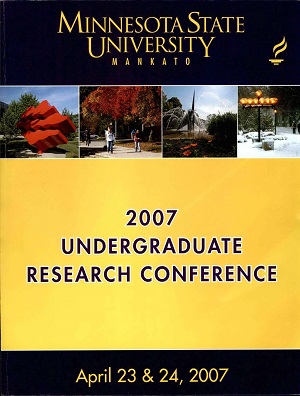Antibiotic Resistance of Enteric Microorganisms Isolated From River Water
Location
CSU 253/4/5
Start Date
23-4-2007 1:00 PM
End Date
23-4-2007 3:00 PM
Student's Major
Biological Sciences
Student's College
Science, Engineering and Technology
Mentor's Name
Timothy Secott
Mentor's Department
Biological Sciences
Mentor's College
Science, Engineering and Technology
Description
Pathogenic bacteria can acquire antimicrobial resistance genes from non-pathogenic organisms present in the environment. Such traits can be selected for and enhanced by prolonged exposure to subtherapeutic doses of antimicrobials. When these traits become established in non-pathogenic Gram-negative enteric bacteria such as coliforms, the chances of eventual transfer to pathogens such as Salmonella and Shigella increase. In order to determine whether coliforms isolated from water could potentially serve as a reservoir for antimicrobial resistance, we evaluated antimicrobial resistance in Escherichia coli and related organisms isolated from water samples taken from the Minnesota River Basin. E. coli and other isolates recovered from water samples were tested for susceptibility to a range of concentrations of ampicillin and tetracycline, and the minimum concentration of either antibiotic needed to prevent the growth of each isolate (MIC) was determined. The range of drug concentrations studied for each drug was chosen based on clinically relevant concentrations. Present data indicated that tetracycline MICs for E. coli ranged from 2-4 micrograms/ml, while MICs for ampicillin were greater than 32 micrograms/ml. These data will constitute a baseline for the monitoring of antibiotic resistance coliforms isolated from water in South Central Minnesota.
Antibiotic Resistance of Enteric Microorganisms Isolated From River Water
CSU 253/4/5
Pathogenic bacteria can acquire antimicrobial resistance genes from non-pathogenic organisms present in the environment. Such traits can be selected for and enhanced by prolonged exposure to subtherapeutic doses of antimicrobials. When these traits become established in non-pathogenic Gram-negative enteric bacteria such as coliforms, the chances of eventual transfer to pathogens such as Salmonella and Shigella increase. In order to determine whether coliforms isolated from water could potentially serve as a reservoir for antimicrobial resistance, we evaluated antimicrobial resistance in Escherichia coli and related organisms isolated from water samples taken from the Minnesota River Basin. E. coli and other isolates recovered from water samples were tested for susceptibility to a range of concentrations of ampicillin and tetracycline, and the minimum concentration of either antibiotic needed to prevent the growth of each isolate (MIC) was determined. The range of drug concentrations studied for each drug was chosen based on clinically relevant concentrations. Present data indicated that tetracycline MICs for E. coli ranged from 2-4 micrograms/ml, while MICs for ampicillin were greater than 32 micrograms/ml. These data will constitute a baseline for the monitoring of antibiotic resistance coliforms isolated from water in South Central Minnesota.
Recommended Citation
Mauland, Elizabeth and Erik Miller. "Antibiotic Resistance of Enteric Microorganisms Isolated From River Water." Undergraduate Research Symposium, Mankato, MN, April 23, 2007.
https://cornerstone.lib.mnsu.edu/urs/2007/poster-session-A/10




